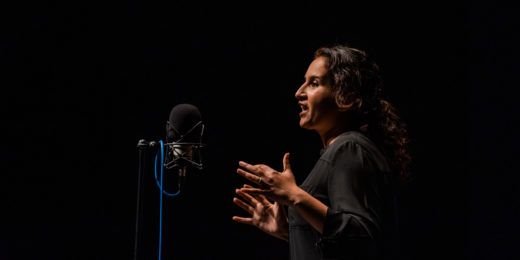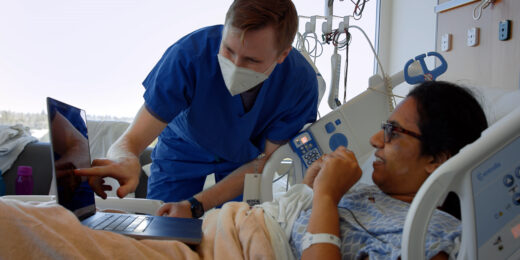Mare Lucas felt euphoric. As if watching a movie about her life shot from a camera high above, she saw herself giving birth to her youngest son, now 17, surrounded by a happy family. Then she watched herself birthing her oldest son, Zane, who had died by suicide in 2017 at age 18.
His birth had been a particularly difficult and dangerous one, and his death created a lasting trauma -- but now all she felt was overwhelming love and joy. She soaked in the beauty of the scene.
Then Lucas heard a voice over her right shoulder. "Hello Mare, can you hear my voice? Are you having happy dreams?" It was her anesthesiologist. And, yes, she was. "If you're having a good experience, I'm going to put you back under for a little bit while they finish up."
Are you having happy dreams? If you're having a good experience, I'm going to put you back under for a little bit while they finish up.
The anesthesiologist adjusted the infusion of propofol, a common sedative used in surgical anesthesia, and carefully monitored her brain waves using electroencephalography. Lucas fell back into a dream state.
This time, she saw the park near their house and watched from above as Zane, around the age when he died, and her youngest son ran around with the family dog, a little corgi. Zane had always wanted a dog, but they hadn't been able to get one until after his death. She was so grateful to have this moment.
Transformative dreams
It was August 2022 and Lucas had gone into surgery at Stanford Health Care to remove a lump in her right breast. She'd already undergone chemotherapy for breast cancer. Her son's death and her cancer diagnosis, not to mention the pandemic, had made the last few years a blur of fear and anxiety.
She had been diagnosed with post-traumatic stress disorder and still regularly had nightmares about Zane's suicide from which she would wake up screaming.
"When you have that many nightmares, you're afraid to go to bed," said Lucas, 59, a communications professional and mother of four living in Palo Alto.
But the morning after the surgery, she awoke with a surprising sense of calm. For the first time in ages, her anxiety felt manageable. She remembered vividly the dreams she'd had during surgery -- they felt more real than any dream she'd had before -- though she struggled to describe them to her husband. "I really thought that I had visited Zane in some other dimension I can't explain," she said.
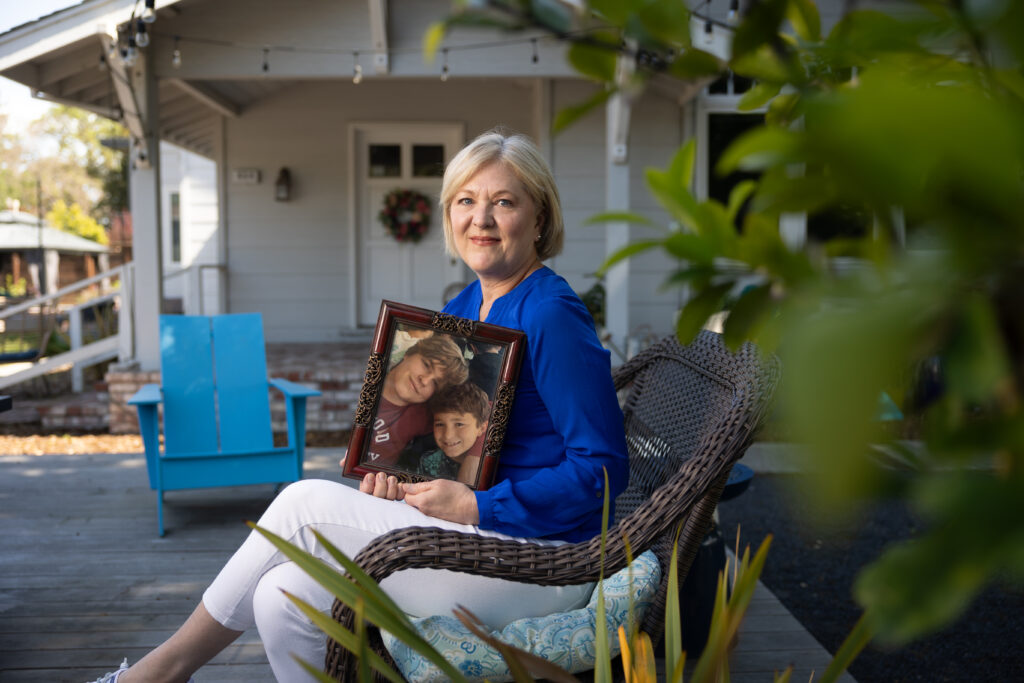
Two days later, she was having lunch at a restaurant when she got a call. It was the voice she'd heard over her right shoulder that day in surgery. Harrison Chow, MD, wasn't sure Lucas would remember him -- anesthesiologists typically meet with patients for only a few minutes before a procedure. But Chow had been struck by what she'd said to him.
Coming out of her propofol-induced dream, Lucas had tried to explain to Chow what she had experienced, tried to describe seeing her son who had died. She was crying and smiling at the same time. She told him, "Thank you for giving me that time with my son."
Chow was calling Lucas to see if she'd answer some more questions. She hadn't been the only one who had experienced something so transformative during anesthesia.
No more nightmares
In March, Chow and colleagues at Stanford Medicine published a report in The American Journal of Psychiatry about two patients, including Lucas, whose trauma symptoms improved after anesthetic-induced dreaming during surgery. The other patient was a 72-year-old woman who had lost her son to a college fraternity hazing incident in 2000.
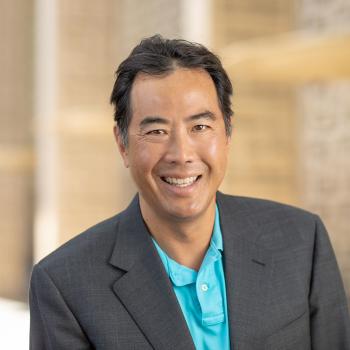
In retrospective evaluations of their psychiatric health, both patients met the criteria for PTSD prior to surgery. A month after surgery, neither did. Their scores on standard ratings of depression and anxiety also improved. When Lucas was evaluated again 11 months after surgery, her symptoms of PTSD, depression and anxiety were nearly gone. She was sleeping better, no longer plagued by nightmares.
It was as if their dream experiences had released both women from the grips of trauma.
"There was something about the euphoria that came with this dream that somehow knocked my brain out of those trauma connections," Lucas said.
The effect of anesthetic-induced dreaming may be similar to that of psychedelic-assisted therapy, which has shown promise in helping people process trauma, said Boris Heifets, MD, PhD, assistant professor of anesthesiology, perioperative and pain medicine.
"This really centers on the role of a powerful experience in transforming people's behavior and outlook," said Heifets, with Chow a co-senior author of the new study.
Tuning into a frequency
Chow had long noticed that his patients dreamt while under anesthesia. "It was something that was fun for patients because they were always great dreams, very pleasant," he said.
As anesthesiology has advanced, its drugs have become safer and more precise. Anesthesiologists continuously monitor vital signs and brain activity using new technology and can titrate medications to control pain, immobility and a patient's level of consciousness.
Chow had become adept at adjusting the dosage of propofol to achieve a certain level of consciousness at the end of a surgery, which allowed patients to come out of anesthesia more gradually, without the hangover effect that typically followed. This also seemed to be the brain state when patients had their pleasant dreams, he noticed.
"It's almost like tuning into a radio station," said Chow, clinical associate professor of anesthesiology, perioperative and pain medicine. "We've been doing this with propofol, but it's really about tuning into that frequency."

"We reduce the anesthetics to the amount where the person is still sedated but the cortex is more activated," explained Pilleriin Sikka, PhD, co-lead author of the new study, who is a postdoctoral scholar in anesthesiology, perioperative and pain medicine. "There's already some activity happening in certain parts of the cortex -- and that seems to be related to dreaming during anesthesia."
The induced dream state may last only minutes, but like normal dreams, patients often perceive them as much longer. Lucas remembers her dreams as "full-blown movies."
Yet dreams under anesthesia are not everyday dreams, which occur during REM sleep. The brain activity is similar but distinct. Most everyday dreams are bad dreams, tending towards the negative, while most anesthesia dreams are positive.
Chow and Heifets began testing this protocol several years ago, initially to improve the patient experience.
"All we're doing is waking up patients a little bit slower, which in many cases is desirable," Heifets said. "A nice, gentle landing from a flight."
All we're doing is waking up patients a little bit slower, which in many cases is desirable. A nice, gentle landing from a flight.
Boris Heifets
Over hundreds of surgeries, they asked patients about their dreams after awakening. They never prompted the patients about their trauma history or what they might dream about. Anecdotally, they began hearing from patients who said their anxiety about certain experiences had dissipated, at least temporarily, after dreaming about them under anesthesia.

In 2022, the researchers published a case report about a young woman whose acute stress disorder, brought on by a recent knife attack, disappeared after dreaming about the incident during hand surgery. In her dream, she relived the traumatic attack, received medical care and surgery, and returned home with a healed hand.
These cases, although only observational, suggest that anesthesia, beyond its purpose during surgery, could have long-lasting, therapeutic effects. "It was a fundamental change in my understanding of anesthesia," Chow said.
Accelerated exposure therapy
It's not yet clear how anesthetic-induced dreams wipe away trauma symptoms, but the researchers hypothesize it may work as an accelerated form of exposure therapy.
"The gold standard for PTSD treatment is prolonged exposure, where people are in a safe environment and they're going through their traumatic memories over and over again," said Laura Hack, MD, PhD, co-lead author of the new study and an assistant professor of psychiatry and behavioral sciences. The practice of confronting traumatic memories in a low arousal state can replace the memory with a new one that carries less emotional pain.
Traditional exposure therapy is a long, trying process, Hack said: "It usually takes nine to 12 sessions of 90 minutes each. And the problem is that people often drop out because, initially, it can be very upsetting."
In anesthetic-induced dreaming, patients process the traumatic memories with a calm body and mind. The dreams often include anxiety-provoking elements -- a knife attack, or a deceased loved one, for example -- but they lead to a pleasant resolution or are part of a happy story.
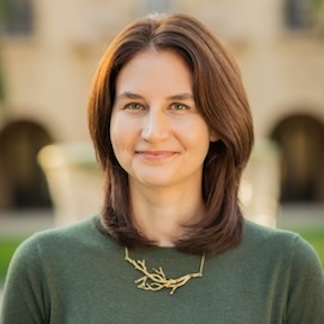
"There has been a strong focus on biochemistry and pharmacology in mental health, but these cases are a profound demonstration that experience matters," Heifets said. "And we have a unique way to deliver a transformative experience in a very safe manner."
The researchers have been perfecting their ability to induce dream states during surgery. The next step would be to bring anesthetic-induced dreaming out of the surgical context. "First in healthy individuals to see how consistently we can induce such a dream state and to figure out the specific neural markers using EEG," Sikka said.
Eventually -- with enough funding -- the researchers hope to develop the protocol into a therapy for psychiatric conditions. It could help people heal from long-term trauma and has potential as a rapid-acting intervention for those in mental health crisis.
For Lucas, that day can't come soon enough. People, like her son Zane, who struggled for years with his mental health, need more options. She believes such an intervention may have saved his life.
"The time to get solutions like this into mainstream medicine is now," she said.
Illustration: Emily Moskal
ALSO
- Two key brain systems are central to psychosis, Stanford Medicine-led study finds
- Pilot study shows ketogenic diet improves severe mental illness
- Psychoactive drug ibogaine effectively treats traumatic brain injury in special ops military vets
- Serious talk about moods with bipolar disorder expert Po Wang
- Human Neural Circuitry program seeks to investigate deepest mysteries of brain function, dysfunction



